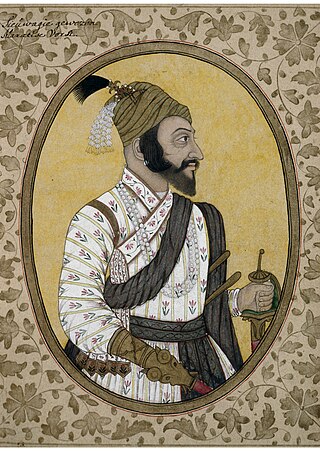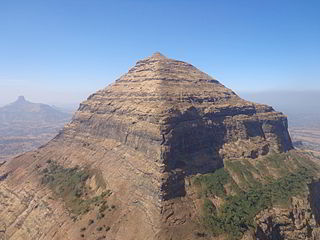
Shivaji I was an Indian ruler and a member of the Bhonsle dynasty. Shivaji carved out his own independent kingdom from the Sultanate of Bijapur that formed the genesis of the Maratha Confederacy. In 1674, he was formally crowned the Chhatrapati of his realm at Raigad Fort.

Sambhaji, also known as Shambhuraje, was the second Chhatrapati of the Maratha Empire, ruling from 1681 to 1689. He was the eldest son of Shivaji, the founder of the Maratha Kingdom. Sambhaji's rule was largely shaped by the ongoing wars between the Marathas and the Mughal Empire, as well as other neighbouring powers such as the Abyssinians of Janjira, Wadiyars of Mysore and the Portuguese Empire in Goa. After Sambhaji's execution by Aurangzeb, his brother Rajaram I succeeded him as the next Chhatrapati and continued the Mughal–Maratha Wars.

Prataprao Gujar also known as Kudtoji Gujar was a Maratha general and held the position of the 3rd Senapati of the Maratha Empire during the reign of Chhatrapati Shivaji. Prataprao Gujar led Chatrapati Shivaji Maharaj's army until 1674.
Netoji Palkar (1620–1681), also known as Netaji Palkar, served as a prominent Maratha general and held the esteemed position of the 2nd Senapati of the Maratha Army under the leadership of Chhatrapati Shivaji, the visionary founder of the Maratha empire.

Rajaram Bhonsle I was the third Chhatrapati of the Maratha Kingdom, who ruled from 1689 to his death in 1700. He was the second son of the Shivaji, the founder of the empire and younger half-brother of Sambhaji, whom he succeeded. His eleven-year reign was marked with a constant struggle against the Mughals. He was succeeded by his infant son Shivaji II under the regentship of his dowager Maharani Tarabai.

Maharani Tarabai Bhosale (née Mohite) was the regent of the Maratha Empire from 1700 until 1708. She was the queen of Rajaram I, and daughter-in-law of the kingdom's founder Shivaji I. She is acclaimed for her role in keeping alive the resistance against Mughal rule in Konkan, and acting as the regent of the Maratha Empire during the minority of her son, Shivaji II. She defeated Mughal forces of Aurangzeb in several battles and expanded the Maratha Empire.

Salher is a place located near Salher Village in Satana tehsil in Nashik district of Maharashtra, India.The old name of Salher was Gavalgarh. It is the site of the highest fort in the Sahyadri mountains and the second highest peak at 1,567 metres (5,141 ft) after Kalsubai in Maharashtra and 32nd highest peak in Western Ghats. This was a fort of the Maratha Empire. The money acquired after raiding Surat was brought to this fort first on its way to the Maratha capital forts.
Shirur is an administrative subdivision of the Pune district in the Indian state of Maharashtra. It is located on the eastern boundary of the district, on the banks of the Ghod River. The town is also called Ghodnadi to distinguish it from other locations that have the same name. Ghodnadi in Marathi Language means Ghod River.
Rajmatoshree Shrimant Soyarabai Saheb Bhosale(Mohite) died 1681) was second wife of Shivaji Maharaj, the founder of Maratha empire in western India. She was mother of Shivaji Maharaj's second son, Rajaram. She was the younger sister of Maratha army chief Hambirrao Mohite.

Dhanaji Jadhav also known as Dhanaji Jadhav Rao, was a prominent Maratha general and served as the Senapati of the Maratha Empire during the reigns of Rajaram I, Tarabai, and Shahu I. Alongside Santaji Ghorpade, he conducted highly successful campaigns against the Mughals from 1689 to 1696, contributing significantly to the Maratha cause. Furthermore, he played a pivotal role in the initial expansion of the Gujarat Province while consistently defeating Mughal forces.
Senapati is a title in ancient India denoting the rank of General.
The powada is a genre of Marathi poetry that was during the late 17th century in India. Powada, which means ‘to glorify’, is a traditional Marathi ballad that traces its history to more than 750 years Powadas often glorified and celebrated deeds of popular folk figures and leaders such as Chhatrapati Shivaji and Tanaji Malusare, and were also written to raise awareness on social issues such as female foeticide, dowry and corruption. Powadas were also used as a medium to create awareness during Samyukta Maharashtra movement.

The following list includes a brief about the titles of nobility or orders of chivalry used by the Marathas of India and by the Marathis/Konkanis in general.
Janki Bhosale was queen consort of the Maratha Empire as the first wife of Rajaram I. She was the daughter of Prataprao Gujar, the 3rd Senapati of the Maratha Empire.
Kavathe is a village located in Shirur Taluka of the Pune district of Maharashtra state. The village adds the name of local hindu goddess 'Yemai' for distinguishing from other villages in Maharashtra with similar name. Kavathe is known for it historical link with Maratha Empire and because of various folk art & artiste associated with Tamasha, drama, Jagaran-Gondhal and Bharud. Poet Bashir Momin Kavathekar and Dholak performer Shri Gangaram Bua are the two prominent folk artiste who had brought laurels with their notable contribution to the Maharashtra's performing art, culture and traditional art form Tamasha. Vithabai Bhau Mang Narayangaonkar's grandfather Shri Narayan Khude who formed his own Tamasha Troupe was also from Kavathe Yamai.
The Battle of Salher was fought between the Marathas and the Mughal Empire in February 1672 CE. The battle was fought near the fort of Salher in modern-day Nashik district. The result was a decisive victory for the Marathas. This battle is considered particularly significant as it is the first pitched battle where the Mughal Empire lost to the Marathas.

Bashir Kamruddin Momin, popularly known by his pen name, Momin Kavathekar, also known as 'Lokshahir B. K. Momin Kavathekar', was a popular Marathi language poet and writer who promoted sanitation, literacy, and social reforms through his literatures. His work involved raising public awareness to tackle issues like dowry system, female foeticide, alcohol addiction and blind following of superstitions.Many of his devotional songs adore the Hindu God & Goddess. He was closely associated with Maharashtra's traditional form of theatre Tamasha for almost 50 years; supporting the various Tamasha troupes by providing them with folk songs like 'Lavani', 'Gan Gavalan', 'Bhedic' and short plays called 'Vaga-Natya'.For his contribution to the field of folk art, literature and culture, he was awarded the 'Vithabai Narayangavkar Jeevan Gaurav Puraskar' by the Government of Maharashtra in 2018.

Raja Shivchatrapati is a Marathi historical drama television series based on Chhatrapati Shivaji Maharaj, founder of the Maratha Empire. The serial was re-broadcast in April 2020 during the COVID-19 pandemic.

Vedat Marathe Veer Daudle Saat is an unreleased Indian Marathi-language period drama film directed by Mahesh Manjrekar and produced by Vaseem Qureshi under the banner of Qureshi Productions. The film stars Pravin Tarde, Hardeek Joshi, Vishal Nikam, Jay Dudhane, Utkarsha Shinde and Virat Madke as the seven great Maratha warriors who playing important role to achieve the dream of Swaraj, while Hindi film actor Akshay Kumar in a extended cameo role who marks his Marathi film debut as Chhatrapati Shivaji Maharaj.

The Battle of Umrani was a 1673 battle between the Bijapur Sultanate and the Marathas 45km west of Bijapur.











